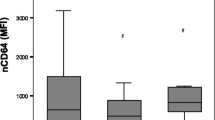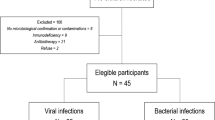Abstract
The purpose of this study was to evaluate the diagnostic accuracy and prognostic value of neutrophil CD64 expression for bacterial infection in febrile adult patients presenting to our hospital emergency department. We prospectively included 132 patients with fever ≥38ºC (≥100.4ºF) during the last 24 hours and we measured CD64 expression on neutrophils the day after admission at the emergency department. We followed the patients until full recovery or death. There were 115 (87%) patients with bacterial infection and 108 (94%) of them survived. There were 17 (13%) patients without bacterial infection and 12 (71%) of them survived. Patients with bacterial infection and patients who survived showed a CD64 index higher when compared with patients without bacterial infection and patients who died, respectively (3.7 ± 3.2 vs. 2.5 ± 2.3; p = 0.03; and 3.7 ± 3.1 vs. 1.7 ± 0.6; p = 0.002; Mann-Whitney U test). The receiver operating characteristic (ROC) curve analysis for detecting bacterial infection and predicting survival with the CD64 index showed an area under curve (AUC) of 0.66 (95% CI, 0.52–0.8; p = 0.03) and 0.71 (95% CI, 0.57–0.85; p = 0.01), respectively. Diagnostic accuracy and prognostic value of CD64 expression was good in adult patients with fever.


Similar content being viewed by others
References
Lever A, Mackenzie I (2007) Sepsis: definition, epidemiology, and diagnosis. BMJ 335:879–883
Martin GS, Mannino DM, Eaton S, Moss M (2003) The epidemiology of sepsis in the United States from 1979 through 2000. N Engl J Med 348:1546–1554
Ng PC, Lam HS (2006) Diagnostic markers for neonatal sepsis. Curr Opin Pediatr 18:125–131
Simon L, Gauvin F, Amre DK, Saint-Louis P, Lacroix J (2004) Serum procalcitonin and C-reactive protein levels as markers of bacterial infection: a systematic review and meta-analysis. Clin Infect Dis 39:206–217
Hoffmann JJ (2009) Neutrophil CD64: a diagnostic marker for infection and sepsis. Clin Chem Lab Med 47:903–916
Davis BH (2005) Improved diagnostic approaches to infection/sepsis detection. Expert Rev Mol Diagn 5:193–207
Levy MM, Fink MP, Marshall JC, Abraham E, Angus D, Cook D, Cohen J, Opal SM, Vincent JL, Ramsay G (2003) 2001 SCCM/ESICM/ACCP/ATS/SIS International Sepsis Definitions Conference. Crit Care Med 31:1250–1256
Calandra T, Cohen J (2005) The international sepsis forum consensus conference on definitions of infection in the intensive care unit. Crit Care Med 33:1538–1548
Sarmati L, Beltrame A, Dori L, Maffongelli G, Cudillo L, De AG, Picardi A, Ottaviani L, Cefalo MG, Venditti A, Amadori S, Arcese W, Andreoni M (2010) Procalcitonin is a reliable marker of severe systemic infection in neutropenic haematological patients with mucositis. Am J Hematol 85:380–383
Zeitoun AA, Gad SS, Attia FM, bu Maziad AS, Bell EF (2010) Evaluation of neutrophilic CD64, interleukin 10 and procalcitonin as diagnostic markers of early- and late-onset neonatal sepsis. Scand J Infect Dis 42:299–305
Icardi M, Erickson Y, Kilborn S, Stewart B, Grief B, Scharnweber G (2009) CD64 index provides simple and predictive testing for detection and monitoring of sepsis and bacterial infection in hospital patients. J Clin Microbiol 47:3914–3919
Cid J, Aguinaco R, Sanchez R, Garcia-Pardo G, Llorente A (2010) Neutrophil CD64 expression as marker of bacterial infection: a systematic review and meta-analysis. J Infect 60:313–319
Charlson M, Szatrowski TP, Peterson J, Gold J (1994) Validation of a combined comorbidity index. J Clin Epidemiol 47:1245–1251
Nuutila J, Hohenthal U, Laitinen I, Kotilainen P, Rajamaki A, Nikoskelainen J, Lilius EM (2007) Simultaneous quantitative analysis of FcgammaRI (CD64) expression on neutrophils and monocytes: a new, improved way to detect infections. J Immunol Methods 328:189–200
Groselj-Grenc M, Ihan A, Pavcnik-Arnol M, Kopitar AN, Gmeiner-Stopar T, Derganc M (2009) Neutrophil and monocyte CD64 indexes, lipopolysaccharide-binding protein, procalcitonin and C-reactive protein in sepsis of critically ill neonates and children. Intensive Care Med 35:1950–1958
Schiff DE, Rae J, Martin TR, Davis BH, Curnutte JT (1997) Increased phagocyte Fc gammaRI expression and improved Fc gamma-receptor-mediated phagocytosis after in vivo recombinant human interferon-gamma treatment of normal human subjects. Blood 90:3187–3194
Davis BH, Bigelow NC, Curnutte JT, Ornvold K (1995) Neutrophil CD64 expression: potential diagnostic indicator of acute inflammation and therapeutic monitor of interferon-gamma therapy. Lab Hematol 1:3–12
Briggs C, Kunka S, Fujimoto H, Hamaguchi Y, Davis BH, Machin SJ (2003) Evaluation of immature granulocyte counts by the XE-IG master: upgraded software for the XE-2100 automated hematology analyzer. Lab Hematol 9:117–124
Sauer M, Tiede K, Fuchs D, Gruhn B, Berger D, Zintl F (2003) Procalcitonin, C-reactive protein, and endotoxin after bone marrow transplantation: identification of children at high risk of morbidity and mortality from sepsis. Bone Marrow Transplant 31:1137–1142
Tillinger W, Jilch R, Jilma B, Brunner H, Koeller U, Lichtenberger C, Waldhor T, Reinisch W (2009) Expression of the high-affinity IgG receptor FcRI (CD64) in patients with inflammatory bowel disease: a new biomarker for gastroenterologic diagnostics. Am J Gastroenterol 104:102–109
Bossuyt PM, Reitsma JB, Bruns DE, Gatsonis CA, Glasziou PP, Irwig LM, Moher D, Rennie D, de Vet HC, Lijmer JG (2003) The STARD statement for reporting studies of diagnostic accuracy: explanation and elaboration. Clin Chem 49:7–18
Bossuyt PM, Reitsma JB, Bruns DE, Gatsonis CA, Glasziou PP, Irwig LM, Lijmer JG, Moher D, Rennie D, de Vet HC (2003) Towards complete and accurate reporting of studies of diagnostic accuracy: the STARD initiative. Standards for Reporting of Diagnostic Accuracy. Clin Chem 49:1–6
Schunemann HJ, Oxman AD, Brozek J, Glasziou P, Bossuyt P, Chang S, Muti P, Jaeschke R, Guyatt GH (2008) GRADE: assessing the quality of evidence for diagnostic recommendations. Evid Based Med 13:162–163
Schunemann HJ, Oxman AD, Brozek J, Glasziou P, Jaeschke R, Vist GE, Williams JW Jr, Kunz R, Craig J, Montori VM, Bossuyt P, Guyatt GH (2008) Grading quality of evidence and strength of recommendations for diagnostic tests and strategies. BMJ 336:1106–1110
Rutjes AW, Reitsma JB, Di Nisio M, Smidt N, van Rijn JC, Bossuyt PM (2006) Evidence of bias and variation in diagnostic accuracy studies. CMAJ 174:469–476
Lijmer JG, Mol BW, Heisterkamp S, Bonsel GJ, Prins MH, van der Meulen JH, Bossuyt PM (1999) Empirical evidence of design-related bias in studies of diagnostic tests. JAMA 282:1061–1066
Livaditi O, Kotanidou A, Psarra A, Dimopoulou I, Sotiropoulou C, Augustatou K, Papasteriades C, Armaganidis A, Roussos C, Orfanos SE, Douzinas EE (2006) Neutrophil CD64 expression and serum IL-8: sensitive early markers of severity and outcome in sepsis. Cytokine 36:283–290
Danikas DD, Karakantza M, Theodorou GL, Sakellaropoulos GC, Gogos CA (2008) Prognostic value of phagocytic activity of neutrophils and monocytes in sepsis. Correlation to CD64 and CD14 antigen expression. Clin Exp Immunol 154:87–97
Song SH, Kim HK, Park MH, Cho HI (2008) Neutrophil CD64 expression is associated with severity and prognosis of disseminated intravascular coagulation. Thromb Res 121:499–507
Matsui T, Ohsumi K, Ozawa N, Shimada K, Sumitomo S, Shimane K, Kawakami M, Nakayama H, Sugii S, Ozawa Y, Tohma S (2006) CD64 on neutrophils is a sensitive and specific marker for detection of infection in patients with rheumatoid arthritis. J Rheumatol 33:2416–2424
Tanaka S, Nishino J, Matsui T, Komiya A, Nishimura K, Tohma S (2009) Neutrophil CD64 expression in the diagnosis of local musculoskeletal infection and the impact of antibiotics. J Bone Joint Surg Br 91:1237–1242
Conflict of interest
The authors declare that they have no conflict of interest.
Author information
Authors and Affiliations
Corresponding author
Rights and permissions
About this article
Cite this article
Cid, J., García-Pardo, G., Aguinaco, R. et al. Neutrophil CD64: diagnostic accuracy and prognostic value in patients presenting to the emergency department. Eur J Clin Microbiol Infect Dis 30, 845–852 (2011). https://doi.org/10.1007/s10096-011-1164-7
Received:
Accepted:
Published:
Issue Date:
DOI: https://doi.org/10.1007/s10096-011-1164-7




